|
|
|
ST-4000XCM 4.2
Megapixel |
Special
Production
ST-4000XCM
4.2
Megapixel, Single-Shot Color,
Large format Self-Guiding, CCD Camera
$A *5800
(*price may vary with $A to $US)
|
|
|
ST-4000XCM 4.2
Megapixel |
The ST-4000XCM uses a large 4.2 megapixel KAI-4020CM color CCD previously available only in an STL camerabody. This CCD has 2048 x 2048 pixels at 7.4 microns square. This is the same size CCD used in the STL-4020 camera. The KAI-4020CM comes in a single class without column defects. The KODAK DIGITAL SCIENCE KAI-4020CM is a high-performance multi-megapixel image sensor designed for a wide range of scientific, medical imaging, and machine vision applications. The 7.4 mm square pixels with microlenses provide high sensitivity. The vertical overflow drain structure provides antiblooming protection, and enables electronic shuttering for precise exposure control to 0.001 seconds. Other features include low read noise, low dark current, negligible lag and low smear. This CCD uses a high gain output amplifier that reduces the read noise by almost half compared to previous versions. Our preliminary tests of this CCD installed in prototype ST camera body exhibits a read noise of less than 8e- rms and a dark current of less than 0.1e- at 0 degrees C. The KAI-4020CM CCD is a progressive scan detector with an active image area of 15.2 x 15.2 mm.
Features:
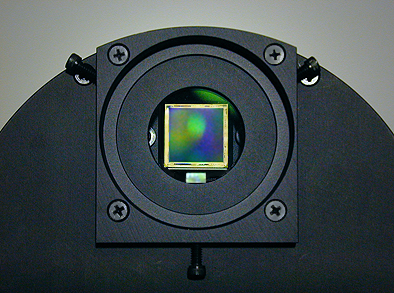 |
|
KAI-4020CM
Imaging CCD and TC-237H Guiding CCD |
This generous 4.2 Megpaixel CCD is twice the size as the KAI-2020CM used in the ST-2000XCM camera. It is approximately 50% larger than the KAF-3200ME CCD used in the ST-10XME. With a diagonal measurement of ~21.5mm, it is the largest CCD currently available in the ST series camera body. Because of the size of the sensor package, this camera is only available in single-shot color in the ST body, without filter wheel. For monochrome with 2" filters, there is no significant savings over the STL model that includes a 2" filter wheel. SBIG has made a special buy of CCDs for this camera and the low price we are offering on the ST-4000XCM is limited by the supply of CCDs we have on hand. It is a substantial supply, but once they are gone this special will end.
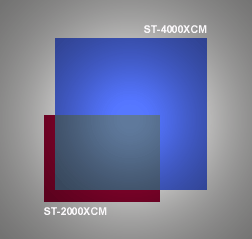 |
|
Relative CCD Sizes |
The ST-4000XCM camera comes with a built-in, custom designed, MAR coated, UV+IR blocking filter for optimum color balance in astronomical imaging and improved performance with camera lenses and short fast refractors. The characteristics of this custom filter are essentially the same as the separate Baader UV+IR blocking filter ("Luminance Filter") that we include with other single-shot color cameras. Since no external UV/IR blocking filter is required, using a camera lens is a simple matter of attaching a lens adapter. The built-in UV+IR filter helps shape the red cut-off but does not significantly attenuate the important wavelengths of H-alpha and [SII]. The UV+IR filter has better than 97% transmission at H-alpha. Additionally, the transmission curves of the RGB filters on the CCD itself happen to place the mostly unwanted wavelength of Sodium light pollution in the minimum gap between the red and green filters while passing H-alpha and [SII]. The peak red transmission is around 525nm. By way of comparison, typical unmodified DSLR cameras tend to have peak red transmission around 600nm with a significant fall off at H-alpha and almost no response to [SII]. This means that the DSLR is roughly twice as sensitive to Sodium light pollution as it is to H-alpha. The opposite is true for the ST-4000XCM where the curve of the red filter attenuates the Sodium line and transmits twice as much light near H-alpha (See charts below).
The ST-4000XCM supports the optional Remote Guiding Head and is fully compatible with the new AO-8 Adaptive Optics accessory. It has the standard ST camera heat exchanger with water cooling capability. With both a mechanical and electronic shutter, the ST-4000XCM can automatically take dark frames as needed with exposure times from 0.001 seconds to 1 hour. Self-guiding is possible with either the built-in TC-237H CCD or the optional Remote Guide Head with external TC-237H CCD.
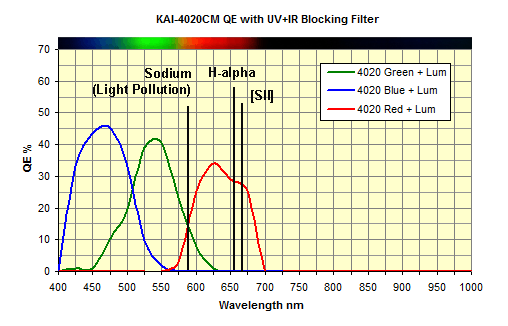 |
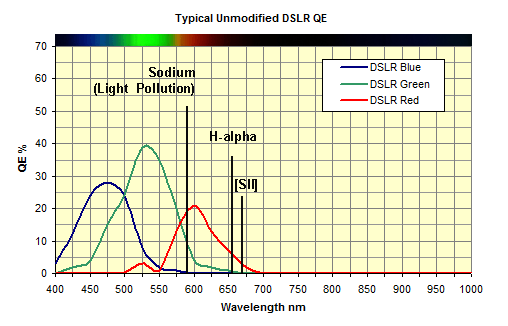 |
|
The STL-4000XCM
is balanced better for astronomical use. It has |
A typical DSLR is
balanced for daylight. The red filter is nearly centered on |
Note: Absolute QE for the DSLR is estimated.
A Natural Step-Up From a DSLR
We are sometimes asked by DSLR users considering moving up to a dedicated astronomical CCD camera what benefits they will get in one of our Astronomical CCD cameras compared to a less expensive consumer digital camera. The answer, simply, is sensitivity and performance. So what makes an astronomical CCD camera more sensitive and a better performer? The paragraphs below briefly address the various factors that answer this question:
1. Sensitivity
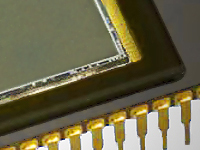 DSLRs are designed to take pictures of terrestrial scenes in daylight
conditions where there is typically plenty of natural light or artificial light
provided by the photographer. Contrast, brightness and dynamic range in
the scenes are high. Exposures are usually very short, fractions of a
second up to several seconds. The noise inherent in the camera is
generally not much of an issue because terrestrial scenes provide plenty of
signal compared to any camera noise. Some consumer cameras have gone a
step further and include a "noise reduction" mode where a dark frame is
subtracted or other processing steps are taken in the camera to reduce
unacceptable levels of noise for dark scenes that require longer
exposures. Even with this enhancement, however, consumer digital cameras
are generally limited to exposures of a few minutes before camera noise becomes
a problem when used for astronomy.
DSLRs are designed to take pictures of terrestrial scenes in daylight
conditions where there is typically plenty of natural light or artificial light
provided by the photographer. Contrast, brightness and dynamic range in
the scenes are high. Exposures are usually very short, fractions of a
second up to several seconds. The noise inherent in the camera is
generally not much of an issue because terrestrial scenes provide plenty of
signal compared to any camera noise. Some consumer cameras have gone a
step further and include a "noise reduction" mode where a dark frame is
subtracted or other processing steps are taken in the camera to reduce
unacceptable levels of noise for dark scenes that require longer
exposures. Even with this enhancement, however, consumer digital cameras
are generally limited to exposures of a few minutes before camera noise becomes
a problem when used for astronomy.
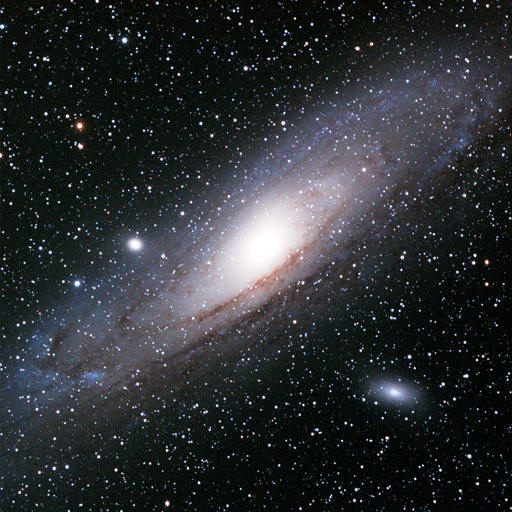 Astronomical CCD
cameras are designed from the beginning to take pictures of very faint objects
at night against a dark background, the proverbial black cat in a coal
bin. There is no possibility of adding artificial light to brighten the
scene. Contrast, brightness and dynamic range are typically very
low. Often, the objects are only a few percent brighter than the
background. Light from the object is at a premium and single exposures up
to an hour long are possible. The camera electronics are designed from the
first step to the last to contribute as little noise to an image as possible
within certain practical limits. The dominant source of noise from the
camera in long exposures however is dark current in the CCD itself. This
is thermally generated charge that can only be reduced by cooling the
sensor.
Astronomical CCD
cameras are designed from the beginning to take pictures of very faint objects
at night against a dark background, the proverbial black cat in a coal
bin. There is no possibility of adding artificial light to brighten the
scene. Contrast, brightness and dynamic range are typically very
low. Often, the objects are only a few percent brighter than the
background. Light from the object is at a premium and single exposures up
to an hour long are possible. The camera electronics are designed from the
first step to the last to contribute as little noise to an image as possible
within certain practical limits. The dominant source of noise from the
camera in long exposures however is dark current in the CCD itself. This
is thermally generated charge that can only be reduced by cooling the
sensor.
Others have compared the sensitivity of cameras based on Kodak CCDs to the sensitivity of popular Canon and Nikon DSLR cameras. Johannes Schedler, known for his excellent DSLR astro images, compared the sensitivity of the STL-11000M camera to his Canon 10D and found the STL-11000M to be about 4 times as sensitive. Christian Buil independently compared Canon 10D, Canon 20D and a Nikon D70 DSLRs to a monochrome Kodak 0402ME based CCD camera and found the 0402ME significantly more sensitive. From the Quantum Efficiency Curves of the KAI-4020M we see that the sensitivity of the KAI-4020M monochrome (and its smaller counterpart, the KAI-2020) is slightly higher than the KAI-11000M. Taking this into account, and the effect of the color filters, it is fair to conclude that the ST-4000XCM is more sensitive than a typical DSLR camera in blue and green wavelengths, and significantly more sensitive in the red and H-alpha. The DSLR's deficiency in red sensitivity can be mitigated to a degree by modifying the camera but even in these cases, exposures are still limited to around 10 minutes due to the dark current in the CCD or CMOS sensor. The ST-4000XCM's thermoelectric cooling and low initial dark current allow the camera to expose an hour at at time, if desired and conditions permit.
The first light image at right is a single, self-guided, 30 minute exposure taken through a TeleVue 4" f/5 refractor by Alan Holmes while testing the guiding performance of the prototype ST-4000XCM camera. The image is reduced to 25% for display.
2. Cooling
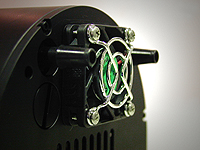
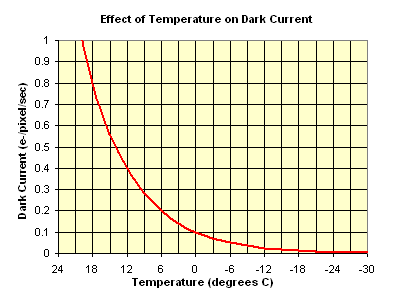 In addition to quantum efficiency and spectral response,
sensitivity to weak signal is improved as the noise from the camera is
reduced. In the case of the KAI-4020CM CCD the read noise is exceptionally
low, typically around 8e- rms. The dark current is also quite low, less
than about 0.1 e- at 0 degrees C. DSLR camera manufacturers can take steps
in their circuit designs to reduce noise from their electronics, but there is
little they can do in circuit design to lower the dark current (and therefore
the dark current noise) that is ever present in an image because dark current is
a property of the CCD itself. Dark current in an image increases in
proportion to the length of the exposure. For terrestrial imaging, with
short exposures, the dark current is so small that it can usually be
ignored. However, for the longer exposures needed for astronomical
imaging, dark current is typically the dominant source of noise from the
camera. Fortunately, another characteristic of CCDs is that dark current
increases with temperature. Conversely, lowering the temperature of the
device lowers the dark current. This is such an important factor for
astronomical imaging that virtually every good dedicated astronomical CCD camera
made has some provision for lowering the temperature of the CCD, even if it is
just the addition of a heat sink to passively dissipate heat from the
device. The ST-4000XCM camera has built-in thermoelectric cooling that
will reduce the temperature of the CCD significantly with air only and even more
with water
circulation. The KAI-4020CM's dark current is reduced by 50% for every
drop of ~ 6 degrees C. Cooling the CCD by 30 to 40 degrees below ambient
lowers the dark current by approximately 100X. This is but one significant
advantage of an astronomical CCD camera and a primary limitation with a consumer
DSLR camera.
In addition to quantum efficiency and spectral response,
sensitivity to weak signal is improved as the noise from the camera is
reduced. In the case of the KAI-4020CM CCD the read noise is exceptionally
low, typically around 8e- rms. The dark current is also quite low, less
than about 0.1 e- at 0 degrees C. DSLR camera manufacturers can take steps
in their circuit designs to reduce noise from their electronics, but there is
little they can do in circuit design to lower the dark current (and therefore
the dark current noise) that is ever present in an image because dark current is
a property of the CCD itself. Dark current in an image increases in
proportion to the length of the exposure. For terrestrial imaging, with
short exposures, the dark current is so small that it can usually be
ignored. However, for the longer exposures needed for astronomical
imaging, dark current is typically the dominant source of noise from the
camera. Fortunately, another characteristic of CCDs is that dark current
increases with temperature. Conversely, lowering the temperature of the
device lowers the dark current. This is such an important factor for
astronomical imaging that virtually every good dedicated astronomical CCD camera
made has some provision for lowering the temperature of the CCD, even if it is
just the addition of a heat sink to passively dissipate heat from the
device. The ST-4000XCM camera has built-in thermoelectric cooling that
will reduce the temperature of the CCD significantly with air only and even more
with water
circulation. The KAI-4020CM's dark current is reduced by 50% for every
drop of ~ 6 degrees C. Cooling the CCD by 30 to 40 degrees below ambient
lowers the dark current by approximately 100X. This is but one significant
advantage of an astronomical CCD camera and a primary limitation with a consumer
DSLR camera.
3. Self-Guiding
![]()
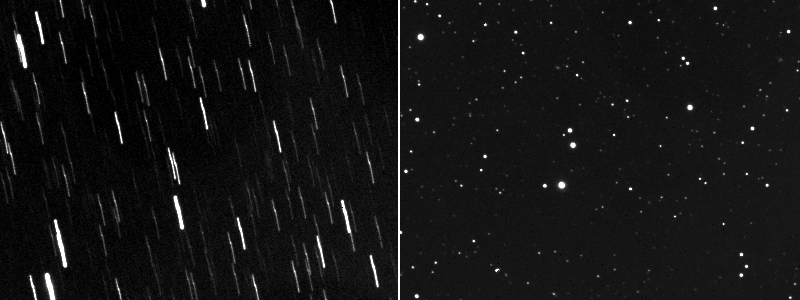 Longer exposures require guiding. The best images of
dim deep space objects you will see are the result of relatively long exposures,
usually many minutes up to several hours total exposure time. Virtually
every telescope mount made for amateur astronomy requires guiding corrections
during long exposures in order to prevent stars from appearing like streaks
instead of points. The need for this depends on the focal length one is
using, the resolution desired in the final image, and the quality of the
mount. But in general, guiding is required for best results when imaging
dim objects even with the best mounts. When imaging with a DSLR, a
separate guider may be added to accomplish this task. There is the added
cost and complexity associated with this: a separate guide scope, good
mounting system and controlling two cameras at the same time. The
ST-4000XCM camera, on the other hand, has a second CCD built into the camera
next to the imaging CCD. This TC-237H guiding CCD is 657 x 495 pixels at
7.4 microns square. It is the same CCD that we previously used as the main
CCD in the ST-237 camera and STV camera/autoguider. This guiding CCD is
controlled with the same software that controls the camera. There is
nothing else to buy, no external cables or mounting requirements, and since the
built-in guiding CCD is looking through the same optical tube as the imaging
CCD, it is the most accurate way to guide a long exposure, particularly when
imaging at a relatively long focal length. If desired, however, an
external guider is easy to add to the ST-4000XCM. Simply plug the optional
Remote Guide Head into
the ST-4000XCM and guiding can be accomplished using a shorter focal length
optical arrangement such as the eFinder. The guiding tests seen in the
pair of images above right were made with a mount intentionally set up with poor
polar alignment in order to test the guiding capability of the Remote Head and
eFinder combination under less than ideal conditions. First an
unguided 10 minute exposure was taken to show the extent of the error (left),
then self-guiding was turned on and a second 10 minute exposure was taken to
determine how well the error was corrected (right).
Longer exposures require guiding. The best images of
dim deep space objects you will see are the result of relatively long exposures,
usually many minutes up to several hours total exposure time. Virtually
every telescope mount made for amateur astronomy requires guiding corrections
during long exposures in order to prevent stars from appearing like streaks
instead of points. The need for this depends on the focal length one is
using, the resolution desired in the final image, and the quality of the
mount. But in general, guiding is required for best results when imaging
dim objects even with the best mounts. When imaging with a DSLR, a
separate guider may be added to accomplish this task. There is the added
cost and complexity associated with this: a separate guide scope, good
mounting system and controlling two cameras at the same time. The
ST-4000XCM camera, on the other hand, has a second CCD built into the camera
next to the imaging CCD. This TC-237H guiding CCD is 657 x 495 pixels at
7.4 microns square. It is the same CCD that we previously used as the main
CCD in the ST-237 camera and STV camera/autoguider. This guiding CCD is
controlled with the same software that controls the camera. There is
nothing else to buy, no external cables or mounting requirements, and since the
built-in guiding CCD is looking through the same optical tube as the imaging
CCD, it is the most accurate way to guide a long exposure, particularly when
imaging at a relatively long focal length. If desired, however, an
external guider is easy to add to the ST-4000XCM. Simply plug the optional
Remote Guide Head into
the ST-4000XCM and guiding can be accomplished using a shorter focal length
optical arrangement such as the eFinder. The guiding tests seen in the
pair of images above right were made with a mount intentionally set up with poor
polar alignment in order to test the guiding capability of the Remote Head and
eFinder combination under less than ideal conditions. First an
unguided 10 minute exposure was taken to show the extent of the error (left),
then self-guiding was turned on and a second 10 minute exposure was taken to
determine how well the error was corrected (right).
4. Adaptive Optics
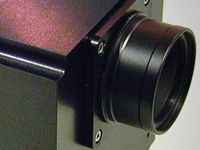
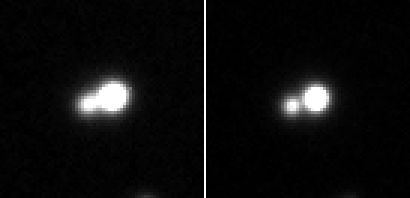 The ST-4000XCM camera fully supports the AO-8 Adaptive Optics
system. SBIG, in concert with Benoit Schillings and Brad Wallis,
introduced the first affordable Adaptive Optics system for imaging deep space
objects with amateur's CCD cameras. This was the AO-7. Since then, we
have added a second generation AO-L for our Large Format
cameras and the newest AO-8 replaces the older AO-7. The AO-8 is
controlled by the on-board guiding CCD in the camera, or by the external guiding
CCD in the Remote Guide Head. The motion of a guide star is monitored and
corrections are made to an optical element in the light path to stabilize the
image on the main CCD. This technique can result in improved
resolution and sharper images. In the case of a poor mount, it can
mean the difference between an unusable image and a good one. In the case
of a good mount and good seeing it can mean the difference between a good image
and a great one. In comparison to the old AO-7, the new AO-8 can follow a
guide star that is drifting over a much wider range, about 40 arcseconds.
Since most good mounts are capable of reducing periodic error to within this
range, no connection to the mount is even required to guide long exposures with
arcsecond accuracy using the AO-8 and the ST-4000XCM (or any ST camera).
Moreover, the AO-8 is capable of making faster, better, moves than can be made
by trying to correcting the mount. This is a tremendous advantage, and a
convenience. The images above, right, are both 15 minute exposures of the
same double star taken on the same night through the same scope, one right after
the other, enlarged 300%. The image on the left is without the AO and the
image on the right is with the AO turned on. In this case the AO
improved the brightness (peak value) and resolution (FWHM) by approximately
30%.
The ST-4000XCM camera fully supports the AO-8 Adaptive Optics
system. SBIG, in concert with Benoit Schillings and Brad Wallis,
introduced the first affordable Adaptive Optics system for imaging deep space
objects with amateur's CCD cameras. This was the AO-7. Since then, we
have added a second generation AO-L for our Large Format
cameras and the newest AO-8 replaces the older AO-7. The AO-8 is
controlled by the on-board guiding CCD in the camera, or by the external guiding
CCD in the Remote Guide Head. The motion of a guide star is monitored and
corrections are made to an optical element in the light path to stabilize the
image on the main CCD. This technique can result in improved
resolution and sharper images. In the case of a poor mount, it can
mean the difference between an unusable image and a good one. In the case
of a good mount and good seeing it can mean the difference between a good image
and a great one. In comparison to the old AO-7, the new AO-8 can follow a
guide star that is drifting over a much wider range, about 40 arcseconds.
Since most good mounts are capable of reducing periodic error to within this
range, no connection to the mount is even required to guide long exposures with
arcsecond accuracy using the AO-8 and the ST-4000XCM (or any ST camera).
Moreover, the AO-8 is capable of making faster, better, moves than can be made
by trying to correcting the mount. This is a tremendous advantage, and a
convenience. The images above, right, are both 15 minute exposures of the
same double star taken on the same night through the same scope, one right after
the other, enlarged 300%. The image on the left is without the AO and the
image on the right is with the AO turned on. In this case the AO
improved the brightness (peak value) and resolution (FWHM) by approximately
30%.
5. Software Support
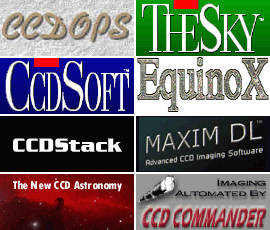
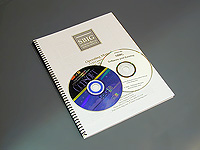 After all is said and done, if a camera is difficult to use
at the telescope, no matter how good the hardware, image quality may
suffer. Getting focused, framing an object that is difficult to see,
processing the results, etc., all go into the final result. Good software
makes these and other tasks easier to get right. The DSLR is designed to
be used in one's hands without extensive external control of the camera's
functions when attached to a telescope at night. It can be done, usually
by adding third party software such as Maxim. This may add cost that needs
to be considered. Like all other SBIG cameras, the ST-4000XCM includes
more excellent software than any other camera from any other
manufacturer.
After all is said and done, if a camera is difficult to use
at the telescope, no matter how good the hardware, image quality may
suffer. Getting focused, framing an object that is difficult to see,
processing the results, etc., all go into the final result. Good software
makes these and other tasks easier to get right. The DSLR is designed to
be used in one's hands without extensive external control of the camera's
functions when attached to a telescope at night. It can be done, usually
by adding third party software such as Maxim. This may add cost that needs
to be considered. Like all other SBIG cameras, the ST-4000XCM includes
more excellent software than any other camera from any other
manufacturer.
Free With Camera
CCDOPS version 5 is SBIG's full featured camera control software for Windows. Our own software package has evolved over the past 15+ years into one of the best, if not the best, basic camera control packages offered by any astronomical CCD camera manufacturer. This software controls all camera functions, self-guiding, autoguiding, color filter wheel and adaptive optics. It also has easy to use single-shot color processing for SBIG color cameras. CCDOPS is free with all SBIG cameras and can be downloaded for free from our web site.
CCDSoftV5 Professional astronomical software package. Jointly developed by SBIG and Software Bisque, CCDSoftV5 incorporates many of the camera control functions of CCDOPS, plus additional camera control features, in addition to its many other astrometry, image processing and telescope control functions. CCDSoftV5 is included with SBIG CCD cameras at no additional charge. Purchased separately it is $349.
TheSky Version 5 TheSky Version 5 is Software Bisque's well known planetarium and start charting software package that includes telescope control for many popular telescope models. This is an indispensable tool for planning an evenings imaging session. Field of view indicators for the imaging and tracking CCD, plus the ability to image link with CCDSoftV5 make TheSky one of the most useful planetarium programs you can own. TheSky version 5, level II, (full functioning demo) is included with all SBIG cameras at no additional charge. Upgrades from Software Bisque are available to higher levels and to the latest version 6.
EquinoX EquinoX software for Mac OS-X operating systems is a planetarium program that now includes SBIG camera control (check with Microprojects for specific camera models). A free copy of EquinoX will be provided on request to new SBIG camea purchasers running Mac OS-X systems. Purchased separately it is $49
Trial Versions and Discounts
Maxim DL/CCD Maxim is the leading third party software package that supports SBIG cameras. As a special accommodation to SBIG camera purchasers, SBIG offers a discount certificate for Maxim DL/CCD at $50 off the list price with any new camera (30 day trial version available from Diffraction Limited).
CCDWARE Titles: A CD with free 60 day trial versions of all of CCDWARE's titles and a $50 discount certificate is included with each new camera. CCDWARE's library of software include:
CCDSTACK
is a native 32-bit processing application that utilizes a
powerful image manager to place all you images in a stack. Once your
images are loaded up in this stack, processing can be performed on your images
as one group of data. This allows for new, advanced image processing
techniques not before available in commercial software. The latest
version of CCDSTACK also includes new processing tools for single shot color
images.
CCDAutoPilot
provides astrophotographers the tools to fully automate an
evenings imaging session. Its advanced features will help you acquire
better data and produce better images. Selecting, framing and managing
your targets is done interactively with tight integration with TheSky6 giving
you real-time feedback to plan complex imaging sequences either
connected to your imaging system or working off-line during the day.
CCDAutoPilot 3.0 Professional adds new multi-target and mosaic capabilities
perfect for unlimited targets for astrophotography and survey work. With
its powerful importers, you can easily create target lists from a wide variety
of applications. Complex Mosaics are achieved with one click, providing
anyone the ability to take wonderful wide field images with very narrow field
equipment.
CCDInspector works
with your camera acquisition software to allow real-time evaluation of images
to determine collimation, camera tilt and focus. Make collimation adjustments
with your CCD camera to an accuracy not available with eyepieces or manual
collimation aids. Batch analyze your images for sharpness and
resolution. Graph and plot your results to assist in future imaging
sessions. Works with CCDSoft5, MaximDL, and more
PEMPro -
With PEMPro Version 2 you can now correct your mounts
periodic error, polar alignment and backlash using your CCD Camera or Webcam
to dramatically improve tracking and guiding.
CCDNavigator - CCDNavigator is a powerful tool that helps you select interesting targets and creates an optimal single or multi-target imaging session plan. Visually plan imaging sessions with thumbnails and availability graphs. Over 23,000 objects in 18 celestial catalogs each with its own thumbnail. Export imaging plans into popular automation programs like CCDAP3.
CCD Commander - CCD Commander will control your CCD camera exposures, your mount movement, and your focuser to completely automate your night's imaging. CCD Commander allows unlimited combinations of these different actions to give you full control of your telescope and camera. The simple to use Graphical User Interface makes these complex configurations very easy to setup. CCD Commander allows you to create an imaging session using a number of different actions. These actions can be setup in any order and you can have any number of them - allowing for unlimited unattended imaging possibilities. A CD with a trial version of CCD Commander is included with all new cameras and SBIG camera owners receive a discount when upgrading to the unrestricted version.
Thee New CCD Astronomy is a great book for beginners. It walks you through every facet of CCD imaging from selecting a camera to taking and processing your first images. A very thorough examination of this new aspect to amateur astronomy. New camera purchasers get a $10 discount certificate. Purchased separately it is $49.
Each new ST-4000XCM camera system includes:
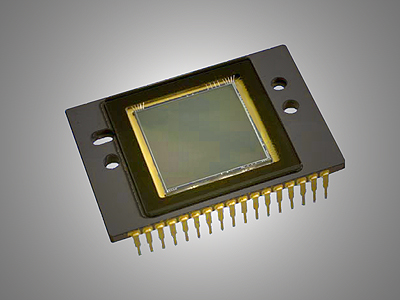 |
Optional Accessories:
ST-4000XCM
Typical
Specifications
|
CCD | |
| CCD | Kodak KAI-4020CM |
|---|---|
| Pixel Array | 2048 x 2048 pixels |
| CCD Size | 15.2 x 15.2 mm (active area) |
| Total Pixels | 4.2 million (active) |
| Pixel Size | 7.4 x 7.4 microns square |
| Full Well Capacity |
~35,000 e- unbinned ~70,000 e- binned |
| Dark Current | < 0.1e-/pixel/sec at 0 deg. C. |
| Antiblooming | Standard |
|
Readout Specifications | |
| Shutter | Electromechanical + Electronic |
|---|---|
| Exposure | 0.001 to 3600 seconds |
| Correlated Double Sampling | Yes |
| A/D Converter | 16 bits |
| A/D Gain |
0.6e-/ADU unbinned 0.9e-/ADU binned |
| Read Noise | 7.9e- rms |
| Color Binning Modes | 1 x 1 |
| Monochrome Binning Modes | 1 x 1, 2 x 2, 3 x 3 |
| Pixel Digitization Rate | up to 425kps |
| Full Frame Download | ~ 10 seconds |
|
System Specifications | |
|---|---|
| Cooling - standard |
Single Stage Thermoelectric, Active Fan, Water Assist -40 C from Ambient Typical with water, -30 C w/air only |
| Temperature Regulation | ±0.1°C |
| Power |
5VDC at 1.5 amps, +/-12VDC at 0.5 amps, power supply included |
| Computer Interface | USB 1.1 |
| Computer Compatibility |
Windows 98/2000/Me/XP Mac OS-X |
| Guiding |
Self-Guiding with built-in TC-237 or Optional Remote Guide Head (external TC-237 CCD) |
|
Physical Dimensions | |
|---|---|
| Optical Head | 5
inches diameter x 3 inches 12.5 cm diameter x 7.5 deep |
| CPU |
All electronics integrated into Optical Head, No CPU |
| Mounting |
T-Thread, 2" nosepieces included |
| Weight | Approx. 2 pounds/0.9kg |
| Backfocus | 0.92 inches / 2.3 cm |
Price and specifications are subject to change without notice